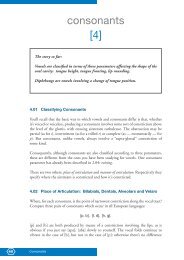PHONETICS MANUAL.indd - HumBox
PHONETICS MANUAL.indd - HumBox
PHONETICS MANUAL.indd - HumBox
You also want an ePaper? Increase the reach of your titles
YUMPU automatically turns print PDFs into web optimized ePapers that Google loves.
Germany. And it’s found in many regional varieties of French. It may be voiced or<br />
voiceless, depending on its position in the word. So common is it in the world’s<br />
languages generally that the letter r, when used as an IPA symbol [r], designates the<br />
alveolar trill, and not any of the other varieties.<br />
Second the FLAP, which, as its name implies, involves a single tap of the tonguetip<br />
against the rear of the upper front teeth or the alveolar ridge. Indeed, TAP is an<br />
alternative term for this sort of r. A flap can be thought of as a truncated trill. The IPA<br />
symbol for both the dental flap and the alveolar flap is [ɾ] (“fish-hook r”), i.e. [r]<br />
minus its ornamental bits and pieces. Flaps (often dental) are found in Spanish as well<br />
as alveolar trills, but the two aren’t interchangeable: sometimes the difference between<br />
them serves to distinguish one word from another: [karo] (carro) means “coach” (with<br />
a trill), but [kaɾo] (caro) means “dear” (with a flap). Note how the spelling uses single<br />
versus double r to convey the difference. In American English an alveolar flapped [ɾ]<br />
commonly replaces [t, d] between vowels ([siɾi] city, [leiɾi] lady, etc.<br />
Thirdly the APPROXIMANT — unknown in Spanish, but the normal variety of r<br />
in most accents of English, and most likely the kind that you use yourself. Prolong<br />
the first consonant of red so as to get the feel of it. You’ll notice that the tip of your<br />
tongue is close to the teethridge, but probably not quite touching, and certainly<br />
not close enough for a fricative to be produced. (And obviously there’s no question<br />
of trilling or flapping.) The sound is actually rather like a vowel produced with the<br />
tongue turned towards the palate (contrast the position for [i], where the surface of<br />
the tongue is much flatter). The term approximant will remind you that the sound<br />
isn’t quite a fricative, but not a proper vowel either. The IPA symbol for the alveolar<br />
approximant is [Ú] (read “turned r”). But in ordinary transcription of English<br />
it’s acceptable to use [r] instead (on the understanding that it’s not being used to<br />
represent a trill). Note how alveolar flaps and approximants can be adjacent to one<br />
another in American English: [la:ɾɹ] ladder, [d@ɹɾi] dirty.<br />
Occasionally in English the [Ú] is devoiced to [Ú] 8 — e.g. when it follows a voiceless<br />
stop in a word like train. The loss of voicing has the effect of turning the approximant<br />
into a fricative, as you can see if you say train slowly to yourself. What’s more, in words<br />
like this, the fricative combines with the t to form an affricate, so that in many people’s<br />
pronunciation there’s little difference between train and chain, or chip and trip.<br />
r serves to demarcate two major accent types of English worldwide. In RP (and some<br />
other varieties), r is heard only before vowels (red, rich); after vowels, any r in the<br />
spelling is silent in the pronunciation (car, bird), UNLESS a word begining with a<br />
vowel immediately follows it, in which case a “linking r” is present (drive the car [r]<br />
away). But in many accents of English (notably American), r is always pronounced<br />
— after vowels (post-vocalically) as well as before them (pre-vocalically). Accents<br />
of the latter type are known as rhotic, accents of the RP type as non-rhotic (after the<br />
Greek letter rho).<br />
Now let’s see how three manners of articulation (trill, fricative and approximant) are<br />
used with the uvular place of articulation, this being particularly relevant to French<br />
and German. Recall that the uvula is the extreme tip of the soft palate (velum).<br />
60 Consonants






